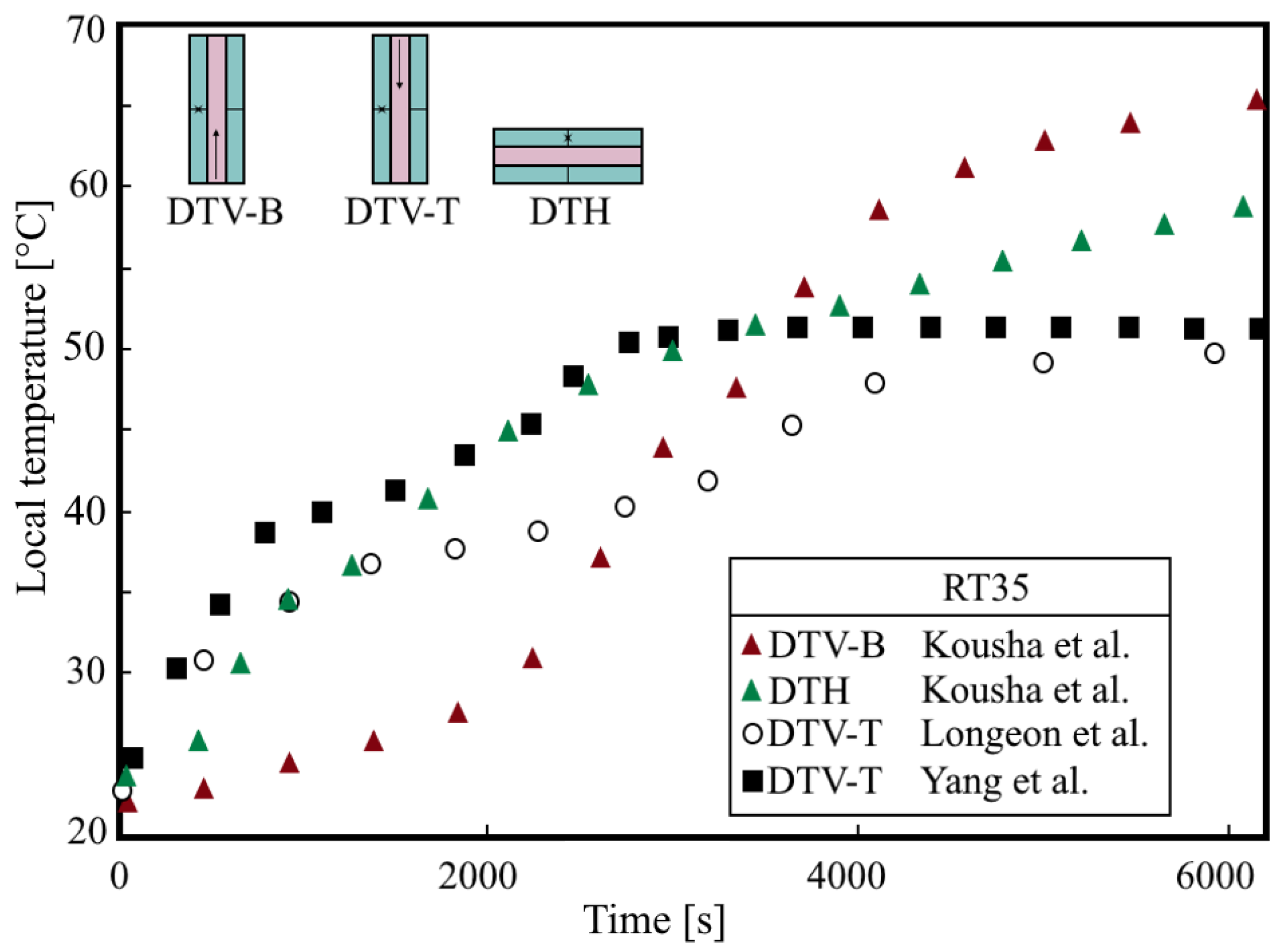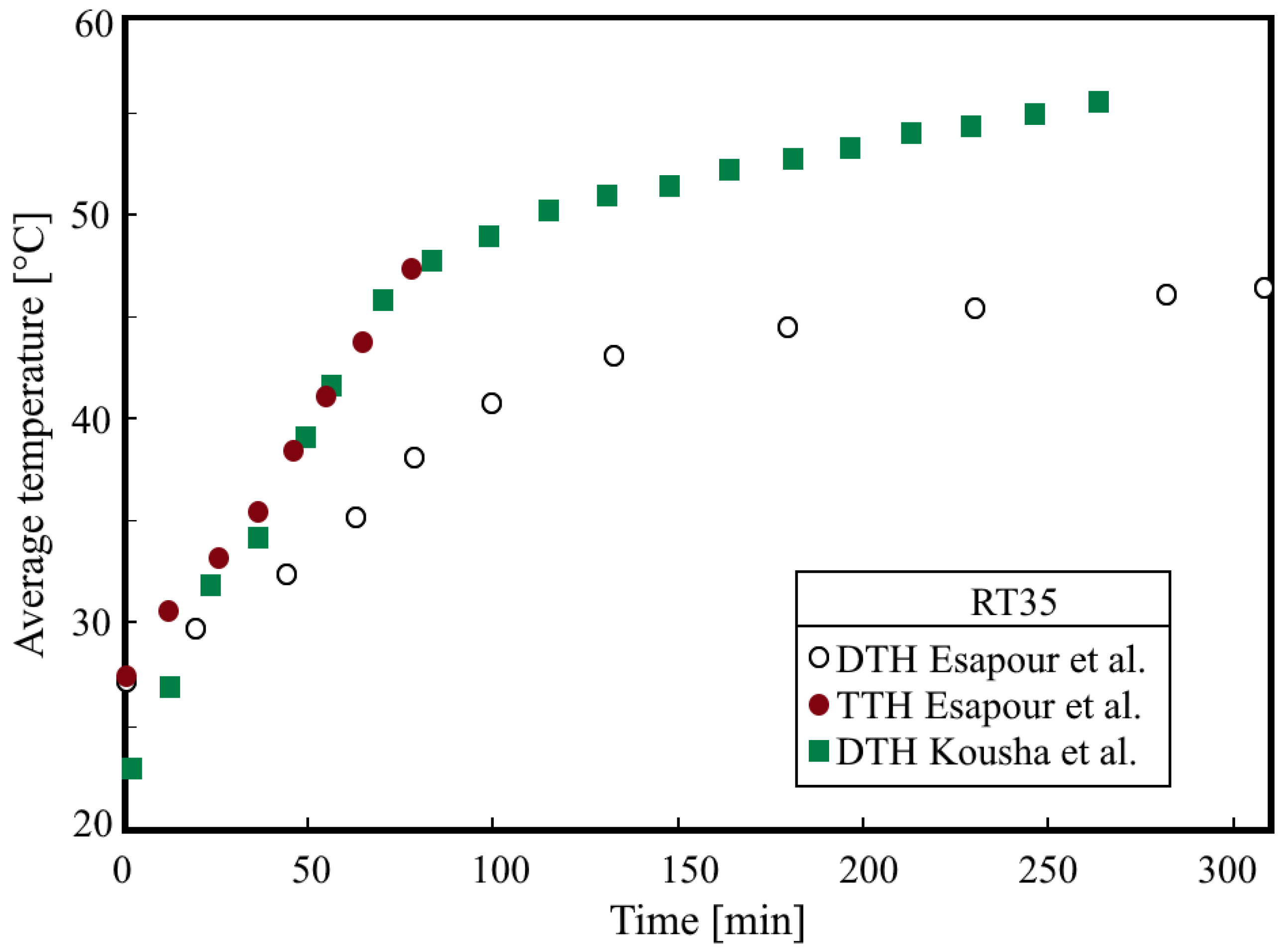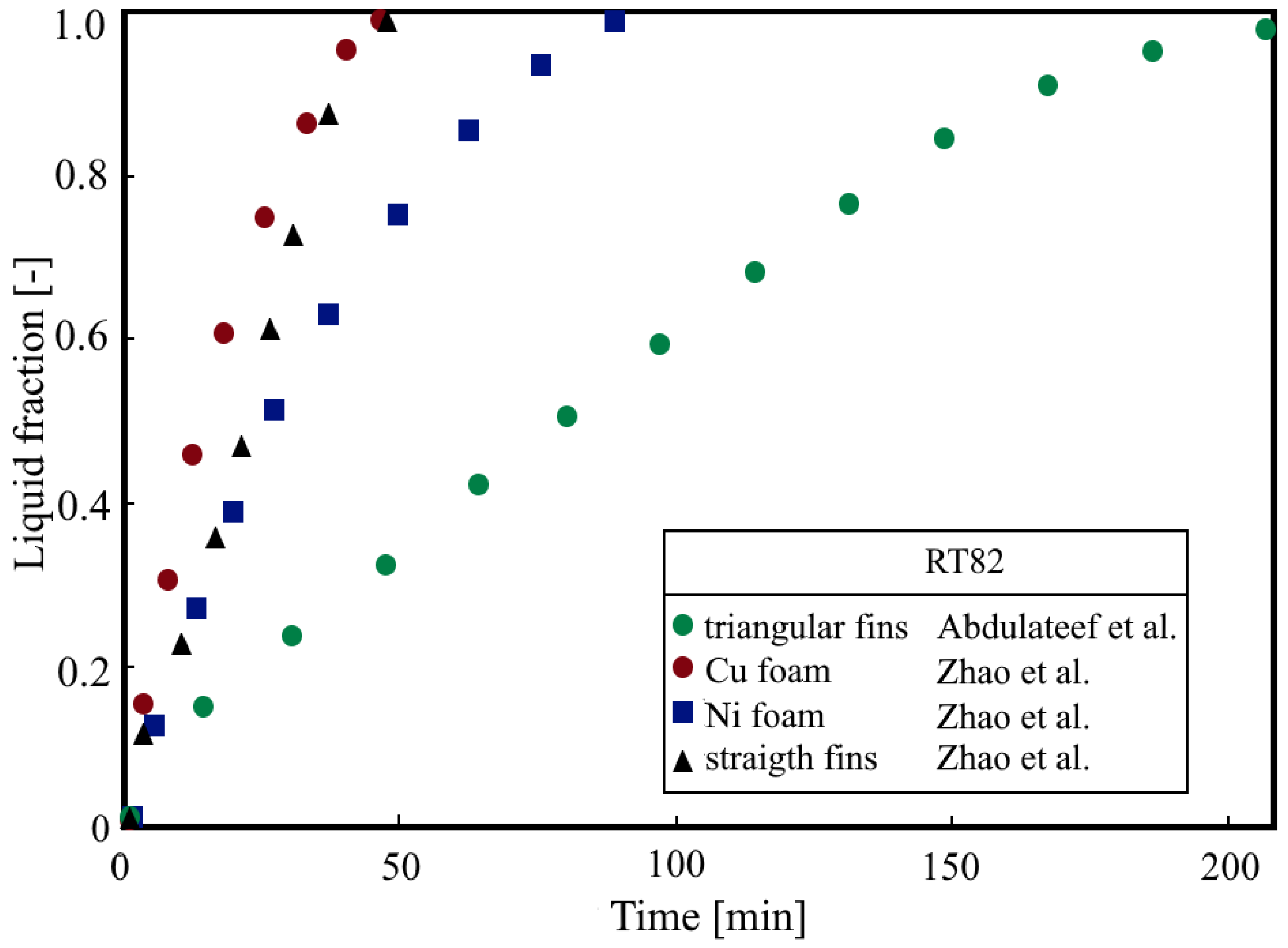Thermal Energy Storage with PCMs in Shell-and-Tube Units: A Review
Abstract
1. Introduction
2. Materials and Methods
2.1. Double-Tube Units
| Executor(s) | Case (Figure 1) | Approach | Geometry | PCM | HTF | PCM HTE/HTFE |
|---|---|---|---|---|---|---|
| Lacroix [26] | DTH-M | Numerical and experiment | dt = 12.7 mm ds = 25.8 mm L = 1000 mm | n-octadekane | Water | Without |
| Adine and Qarnia [29] | DTH-MP-M | Numerical | dt = 12.7 mm ds = 22.7 mm L1 = 470 mm L2 = 530 mm | n-octadekane P116 | Water | Two PCMs |
| Avci and Yazici [31] | DTH-M DTH-S | Experiment | dt,o = 28 mm ds = 110 mm L = 500 mm | P56-58 | Water | Without |
| Hosseini et al. [34] | DTH-M DTH-S | Experiment Numerical | dt,o = 22 mm ds = 85 mm L = 1000 mm | RT50 | Water | Without |
| Kibria et al. [35] | DTH-M DTH-S | Experiment Numerical | dt = 10.8 mm ds = 36 mm L = 1000 mm | Paraffin wax | Water | Without |
| Yazici et al. [36] | DTH-E-S | Experiment | dt,o = 28 mm ds = 110 mm L = 500 mm | P56-58 | Water | HTF tube eccentricity |
| Liu and Groulx [37] | DTH-ILF-M DTH-ILF-S | Experiment | dt,o = 12.7 mm ds = 139.7 mm L = 304.8 mm | Dodecanoic acid | Water | Internal longitudinal fins |
| Tao and He [38] | DTH-MP-IFT-M | Numerical | dt = 25 mm ds = 50 mm L = 1000 mm |
| He/Xe mixture |
|
| Darzi et a. [43] | DTH-El-M DTH-El-S DTH-ILF-M DTH-ILF-S | Numerical | dt = 40 mm ds = 80 mm S = 0.0049 m2 | n-eicosane | Not specified tw = const. |
|
| Tao and Carey [44] | DTH-M | Orthogonal experiment | dt = 25 mm ds = 50 mm L = 1000 mm |
| He/Xe mixture | Without |
| Yuan et al. [45] | DTH-ILF-M | Numerical | dt = 25 mm ds = 50 mm L = 1000 mm | Lauric acid | Not specified tw = const. | Internal longitudinal fins |
| Han et al. [46] | DTH-M DTH-SP-M | Numerical | dt = 10 mm ds = 14.14 mm L = 500 mm | KNO3/NaNO3 salt | Air | Without |
| Kuboth et al. [47] | DTH-CF-S | Numerical | dt = 10 mm ds = 40 mm L = 1000 mm | RT42 | Water | Circular fins |
| Mehta et al. [53] | DTH-M DTH-S | Experiment | dt,i = 28 mm ds,i = 88 mm L = H = 600 mm | Stearic acid | Water | Without |
| Dukhan et al. [54] | DTH-M | Experiment | dt = 25 mm ds = 75 mm L = 700 mm | RT42 | Water | Without |
| Yu et al. [55] | DTH-ILF-M DTH-AF-M | Numerical | dt = 90 mm ds = 304 mm | Lauric acid | Not specified tw = const. | Internal longitudinal fins (straight and fractal tree-like) |
| Huang et al. [56] | DTH-ILF-S | Numerical | dt,i = 40 mm ds = 170 mm | Water | Not specified tw = const. | Internal longitudinal straight fins |
| Liu et al. [57] | DTH-ILF-MP-M DTH-ILF-MP-S | Numerical | dt = 12.7 mm ds = 48.26 mm | RT55 RT60 RT65 | Not specified tw = const. |
|
| Sodhi et al. [58] | DTH-ILF-M DTH-ILF-S DTH-FR-M DTH-FR-S | Numerical | dt = 24.6 mm ds = 92.5 mm L = 700 mm | NaNO3 | Air |
|
| Mahdi et al. [59] | DTH-ILF-M DTH-ILF-S DTH-AF-M DTH-AF-S | Numerical | dt = 20 mm ds = 85 mm L = 700 mm | RT50 | Not specified tw = const. | Internal longitudinal fins (straight and branch shaped) |
| Ye and Khodadadi [61] | DTH-AF-M | Numerical | dt = 14.453 mm ds = 50.8 mm | n -octadekane | Not specified tw = const. | Internal arrow shape-longitudinal fins |
| Li et al. [62] | DTH-ILF-M DTH-ILF-VG-M | Numerical | dt = 22 mm ds = 85 mm L = 1000 mm | RT50 | Water |
|
| Ao et al. [63] | DTH-AF-M | Numerical | dt = 10 mm ds = 30 mm L = 1000 mm |
| Not specified tw = const. | Internal V-shaped longitudinal fins |
| Shakrina et al. [64] | DTH-ILF-M DTH-ILF-S DTH-CF-M DTH-CF-S | Numerical | dt = 26.6/42.2/60.3 mm ds = 46.6/102.2/160.3 mm L = 1000 mm | n-Butane | LNG |
|
| Executor(s) | Case (Figure 2) | Approach | Geometry | PCM | HTF | HTE |
|---|---|---|---|---|---|---|
| Ettouney et al. [27] | DTV-B-SC-M | Experiment | dt = 54 mm ds = 74.2 mm H = 365 mm | Paraffin wax | Water | Screen-balls insert |
| Trp [28] | DTV-T-M DTV-T-S | Experiment and numerical | dt = 33 mm ds = 128 mm H = 1000 mm | Paraffin RT30 | Water | Without |
| Chiu and Martin [30] | DTV-T-CF-M DTV-T-CF-S | Experiment and numerical | dt,i = 7 mm ds = 85 mm H = 150 mm | Paraffin Salt-hydrate | Water | Circular fins |
| Solomon and Velraj [32] | DTV-B-ILF-S | Experiment | dt = 73 mm ds = 140 mm H = 280 mm | RT21 | Air | Longitudinal straight fins |
| Longeon et al. [33] | DTV-B-M DTV-B-S DTV-T-M DTV-T-S | Experiment and numerical | dt = 10 mm ds = 44 mm H = 400 mm | RT35 | Water | Without |
| Rathod and Banerjee [39] | DTV-B-ILF-M | Experiment | dt = 33 mm ds = 128 mm H = 1000 mm | Stearic acid | Water | Longitudinal straight fins |
| Sciacovelli et al. [40] | DTV-T-AF-S | Numerical | dt,o = 21 mm ds = 115 mm | Paraffin wax | Water | Longitudinal Y-shaped fins with single and double bifurcation |
| Seddegh et al. [41] | DTV-B-M DTV-B-S | Numerical | dt,o = 33 mm ds = 128 mm H = 1000 mm | Paraffin wax | Water | Without |
| Hu et al. [42] | DTV-B-FR-MP-M | Numerical | dt,i = 100.28 mm dt,i = 17.2 mm ds = 120 mm H = 300 mm | Paraffin | Water | Frustum–shaped HTF tube Multiple PCMs |
| Tao et al. [48] | DTV-T-M DTV-T-SP-M DTV-T-S | Numerical | dt,i = 25/43.3 mm ds,i = 50 mm H = 1000 mm | LiF/CaF2 | He/Xe mixture | Without |
| Yang et al. [49] | DTV-T-CF-M | Numerical | dt,i = 10 mm ds,i = 44 mm H = 1000 mm | RT35 | Water | Circular fins |
| Seddegh et al. [50] | DTV-T-M DTV-T-S | Experiment and numerical | dt,i = 10 mm ds,i = 44 mm H = 1000 mm | RT60 | Water | Without |
| Pizzolato et al. [51] | DTV-T-AF-S | Topology optimization | Dimensionless parameters | Dimensionless parameters | Not specified | Advanced fins |
| Han et al. [46] | DTV-T-M DTV-B-M DTV-T-SP-M DTV-B-SP-M | Numerical | dt = 10 mm ds = 14.14 mm L = 500 mm | KNO3/NaNO3 salt | Air | Without |
| Mehta et al. [53] | DTV-B-M DTV-B-S | Experiment | dt,i = 28 mm ds,i = 88 mm L = H = 600 mm | Stearic acid | Water | Without |
| Andrzejczyk et al. [60] | DTV-B-M DTV-B-S | Experiment | dt,i = 8 mm ds,i = 40 mm H = 169 mm | Coconut oil | Water | Without |
| Liu et al. [65] | DTV-T-FO-M DTV-T-FO-S | Experiment and numerical | dt,i = 20 mm ds,i = 85 mm H = 300 mm | Paraffin | Water | Metal foam of different pore densities and porosities |
2.2. Triplex-Tube Units
| Executor(s) | Case (Figure 4) | Approach | Geometry | PCM | HTFt | HTFs | HTE |
|---|---|---|---|---|---|---|---|
| Al-Abidi et al. [66] | TTH-M TTH-ILF-M TTH-ILF+ELF-M | Numerical | dt,i = 50.8 mm ds,i = 150 mm dT,i = 200 mm L = 1000 mm | RT82 | Water | Water | Internal/external longitudinal straight fins |
| Al-Abidi et al. [67] | TTH-S TTH-ILF-S TTH-ILF+ELF-S | Numerical | dt,i = 50.8 mm ds,i = 150 mm dT,i = 200 mm L = 480 mm | RT82 | Water | Water | Internal/external longitudinal straight fins |
| Mat et al. [68] | TTH-M TTH-ILF-M TTH-ILF+ELF-M | Numerical | dt,i = 50.8 mm ds,i = 150 mm dT,i = 200 mm L = 480 mm | RT82 | Water | Water | Internal/external longitudinal straight fins |
| Başal and Ünal [69] | TTH-M | Numerical | dt,i = 20 mm ds,i = 40 mm dT,i = 100 mm L = 2000 mm | RT52 | Water | Water | Without |
| Abdulateef et al. [70] | TTH-M TTH-ILF-M TTH-ELF-M TTH-ILF+ELF-M | Experiment and numerical | dt,i = 76.2 mm ds,i = 381 mm dT,i = 500 mm L = 3000 mm | RT82 | Water | Water | Internal/external longitudinal straight and triangular fins |
| Joybari et al. [71] | TTH-IH-M+S TTH-EH-M+S | Numerical | dt,i = 51.02 mm ds,i = 124.64 mm | RT31 | Not specified tw = const. | Not specified tw = const | Without |
| Eslamnezhad an Rahimi [72] | TTH-ILF+ELF-M | Numerical | dt,i =50.8 mm ds,i = 150 mm dT,i = 200 mm L= 3000 mm | RT82 | Water | Water |
|
| Mahdi et al. [74] | TTH-ILF+ELF-M | Numerical | dt,i = 48.4 mm ds,i = 146 mm dT,i = 196 mm L = 500 mm | RT82 | Not specified tw = const. | Not specified tw = const | Internal/external longitudinal straight fins |
| Wang et al. [75] | TTH-WT-S | Numerical | 3 ≤ m ≤ 5.7 0.1 ≤ m ≤ 0.5 | Water Water-Al2O3 | Not specified tw = const. | Not specified tw = const. | Wavy shape of inner wall |
| Mahdi et al. [76] | TTH-IH-ILF+ELF-M+S | Numerical | Not specified | RT82 | HHTF Not specified tw = const. | CHTF Not specified tw = const. | Internal/external longitudinal straight and V-shaped fins |
| Alizadeh et al. [77] | TTH-ELF-S | Numerical | dt,i = 20 mm ds,i = 80 mm | Water | HHTF Not specified tw = const. | CHTF Not specified tw = const. | External longitudinal V-shaped fins |
| Patel and Rathod [78] | TTH-M TTH-S TTH-ILF-M TTH-ILF-S TTH-ELF-M TTH-ELF-S TTH-ILF+ELF-M TTH-ILF+ELF-S | Numerical | dt,i = 22 mm ds,i = 85 mm dT,i = 115 mm L = 2000 mm | RT50 | Not specified tw = const | HTF Not specified tw = const | Internal/external longitudinal straight fins |
| Hosseini and Rahimi [79] | TTH-ILF+ELF-M TTH-ILF+ELF-AT-M | Numerical | dt,i = 50.8 mm ds,i = 150 mm dT,i = 200 mm | RT82 | Not specified tw = const | Not specified tw = const | Internal/external longitudinal straight fins |
| Zhao et al. [80] | DTH-ILF+ELF-M DTH-FO-M | Numerical | dt =48.4 mm ds = 150 mm | RT82 | Not specified tw = const. | Not specified tw = const. |
|
| Mozafari et al. [82] | TTH-ILF-MP-M+S | Numerical | dt,i = 50.8 mm ds,i = 150 mm | RT55 RT60 RT65 | Not specified tw = const. | Not specified tw = const |
|
| NematpourKeshteli et al. [83] | TTH-ILF-M TTH-FO-M | Numerical | dt,i = 40 mm ds,i = 80 mm dT,i = 120 mm L = 2000 mm | RT31 RT35 RT42 | Water | Water |
|
| Yan et al. [85] | TTH-AF-M | Numerical | dt,i = 48.4 mm ds,i = 146 mm dT,i = 196 mm L = 500 mm | RT82 | Water | Water | Internal/external longitudinal Y-shaped fins |
| Executor(s) | Case (Figure 5) | Approach | Geometry | PCM | HTFt | HTFs | HTE |
|---|---|---|---|---|---|---|---|
| Almsater et al. [73] | TTV-T-ILF-M TTV-T-ILF-S | Experiment and numerical | dt,i = 50 mm ds,i = 150 mm dT,i = 200 mm H = 480 mm | Water | Dynalene HC-50 | Dynalene HC-50 | Longitudinal straight fins |
| Sun et al. [81] | TTV-B-T-M TTV-B-T-CF-M | Numerical | dt,i = 18 mm ds,i = 38 mm dT,i = 58 mm H = 250 mm | RT58 | Water | Water | Circular fins |
| Ju et al. [84] | TTV-T-S TTV-B-S TTV-T-BA-S TTV-TA-B-S TTV-T-B-FR-S | Numerical | dt,i,h = 18 mm ds,i,h = 38 mm dT,i, h = 58 mm H = 250 mm | RT35 | Frustum inner and middle tubes |
2.3. Multi-Tube Units
| Executor(s) | Case (Figure 6) | Approach | Geometry | PCM | HTF | HTE |
|---|---|---|---|---|---|---|
| Hendra et al. [86] | MTHS-M | Experiment and numerical | dt,i = 12.7 mm ds = 262.5 mm L = 1000 mm Staggered | Mikro | Water | Without |
| Agyenim et al. [87] | MTHS-M MTHS-S | Experiment | dt,o = 23 mm ds = 146.4 mm L = 937.5 mm Staggered | Erythritol | Not specified tin = 140 °C | Without |
| Agyenim et al. [88] | MTHL-M MTHL-S | Experiment | dt,i = 23 mm ds = 146 mm L = 1000 mm In-line | Erythritol | Not specified 130 ≤ tin ≤ 140 °C | Without |
| Luo et al. [89] | MTHC-M | Numerical | dt = R/6 ds = 2R In-line Staggered Centrosymmetric | Pr = 0.1 Pr = 0.02 | Not specified tw = const. | Without |
| Esapour et al. [90] | MTHL-TT-M | Numerical | 15 ≤ dt,i [mm] ≤ 21.2 ds,i = 95 mm dT,i = 125 mm L = 1000 mm In-line | RT35 | Water | Triplex-tubes |
| Esapour et al. [91] | Numerical | 15 ≤ dt,i [mm] ≤ 21.2 ds,i = 95 mm dT,i = 125 mm L = 1000 mm In-line | RT35 | Water | Triplex-tubes | |
| Al-Mudhafar et al. [92] | MTHL-M MTHL-WBT-M | Numerical | dt,i = 20 mm ds = 150 mm L = 1000 mm In-line | RT82 | Water | Webbed tubes |
| Esapour et al. [93] | MTHL-TT-FO-M MTHL-TT-FO-S | Numerical | 15 ≤ dt,i [mm] ≤ 21.2 ds,i = 95 mm dT,i = 125 mm L = 1000 mm In-line Staggered | RT35 | Water |
|
| Sodhi et al. [95] | MTHC-M MTHC-S | Numerical | 8.7 ≤ dt,i [mm] ≤ 21.4 227.7 ≤ ds,i [mm] ≤ 237.14 Centrosymmetric | NaNO3 | Not specified tw = const. | Without |
| Abreha et al. [96] | MTHC-ILF-M MTHC-ILF-S | Numerical and experiment | dt,i = 17 mm ds = 240 mm Centrosymmetric | Erythritol | Cooking waste oil | Internal longitudinal straight fins |
| Park et al. [97] | MTHC-M MTHL-M MTHS-M | Numerical | 2.25 ≤ dt,i [mm] ≤ 18 38.46 ≤ ds,i [mm] ≤ 41.98 In-line Staggered Centrosymmetric | N-eicosane | Not specified tw = const. | Without |
| Kudachi et al. [98] | MTHC-M | Experiment and numerical | dt,i = 14 mm ds = 108.2 mm L = 600 mm Centrosymmetric | OM65 | Water | Without |
| Mahdi et al. [99] | MTHL-AT-M | Numerical | dt = 10 mm ds = 70 mm L = 600 mm In-line | Lauric acid | Not specified tw = const. | Without |
| Shaikh et al. [101] | MTHL-TT-M | Numerical | 15 ≤ dt,i [mm] ≤ 30 ds = 150 mm dT,i = 200 mm L = 1000 mm In-line | KNO3/NaNO3 salt | Oil | Triplex-tubes |
| Mahdavi et al. [102] | MTHL-M+S MTHL-WBT-M+S | Numerical | dt = 15 mm ds = 70 mm In-line | RT82 | Not specified tw = const. | Fins |
| Qaiser et al. [103] | MTH-AT-ILF-M MTH-SH-ILF-M | Numerical and experiment | 14.355 ≤ dt,i [mm] ≤ 22.698 ds = 121 mm | Stearic acid | Water | Internal longitudinal fins |
| Song et al. [104] | MTHL-AF-M | Numerical | dt = 18 mm ds = 304 mm L = 400 mm In-line | Lauric acid | Not specified tw = const. | Internal longitudinal straight and tree-shaped fins |
| Vikas et al. [105] | MTHL-AT-M MTHS-AT-M | Numerical | dt,o = 12.5 mm ds = 100 mm In-line Staggered | Paraffin wax | Not specified tw = const. | Radial eccentricity of HTF tubes |
| Vikas et al. [106] | MTHL-AT-M | Numerical | dt,o = 12.5 mm ds = 100 mm In-line Staggered | Paraffin wax | Not specified tw = const. |
|
| Zaglanmis et al. [108] | MTHL-M | Numerical | dt,o = 10 mm ds = 80 mm L = 500 mm In-line | RT35 n-eicosane n-octadecane gallium | Water | Without |
| Qaiser et al. [109] | MTHS-P-M | Numerical | dt,o = 16 mm ds = 121 mm Staggered | Stearic acid | Not specified tw = const. | Polygon shape of external cross-section of HTF tubes |
| Fabrykiewicz and Cieśliński [110] | MTHL-M MTHS-M MTHL-S MTHS-S | Experiment | dt,i = 4 mm ds,i = 70 mm L = 400 mm In-line Staggered | LTP56 RT54HC P1808 | Water | Without |
| Executor(s) | Case (Figure 7) | Approach | Geometry | PCM | HTF | HTE |
|---|---|---|---|---|---|---|
| Raul et al. [94] | MTV-T-IFT-S | Experiment | dt,i = 10.4 mm ds = 100 mm H = 800 mm | A164 | Hytherm 600 | Longitudinal straight fins inside HTF |
| Yang et al. [100] | MTV-T-M MTV-B-S | Optimization | dt,o = 17.2 mm | PCMs with specified tm and hm | Not specified tin = 68 °C | Without |
| Wang et al. [107] | MTV-B-AT-S | Numerical | dt,i = 4.6 mm ds = 172.7 mm H = 508 mm | n-octadekane | Air | Non-symmetrical tube bundle |
3. Discussion
4. Conclusions
Funding
Conflicts of Interest
Nomenclature
| d | Diameter | (m) |
| H | Height | (m) |
| L | Length | (m) |
| m | Shape factor | (-) |
| S | Surface area of PCM zone | (m2) |
| t | Temperature | (°C) |
| Greek letters | ||
| θ | Inclination angle | (°) |
| Subscripts | ||
| h | Hydraulic diameter | |
| i | Inside | |
| o | Outside | |
| s | Shell | |
| t | Tube | |
| T | Third tube | |
| w | Wall | |
| Abbreviations | ||
| AF | Advanced fins | |
| AT | Tube bundle arrangement | |
| B | Bottom HTF inlet | |
| BA | Bottom annulus HTF inlet | |
| CF | Circular fins | |
| DT | Double-tube | |
| DTH | Double-tube horizontal | |
| DTI | Double-tube inclined | |
| DTV | Double-tube vertical | |
| E | Eccentricity | |
| EH | External annulus heating | |
| EL | Elliptical | |
| ELF | External longitudinal fins | |
| FO | Foam | |
| FR | Frustum shell or HTF tube | |
| HTE | Heat transfer enhancement | |
| HTF | Heat transfer fluid | |
| HTFE | Heat transfer fluid enhancement | |
| IFT | Internally finned heat transfer fluid tube | |
| IH | Internal tube heating | |
| ILF | Internal longitudinal fins | |
| ILF+ELF | Internal and external longitudinal fins | |
| M | Melting | |
| MP | Multiple PCMs | |
| M+S | Simultaneous melting and solidification | |
| MT | Multi-tube | |
| MTHC | Multi-tube horizontal centrosymmetric | |
| MTHL | Multi-tube horizontal in-line | |
| MTHS | Multi-tube horizontal staggered | |
| MTV | Multi-tube vertical | |
| S | Solidification | |
| SC | Screen | |
| SHE | Elliptical shell | |
| SHT | Triangular shell | |
| SP | PCM in shell side | |
| P | Modified shape of external cross-section of HTF tube | |
| T | Top HTF inlet | |
| TA | Top annulus HTF inlet | |
| TT | Triplex-tube | |
| TESU | Thermal energy storage unit | |
| TTH | Triplex-tube horizontal | |
| TTV | Triplex-tube vertical | |
| VG | Vortex generator inside HTF tube | |
| WT | Wavy HTF tube | |
| WBT | Webbed tubes |
References
- Letcher, T.M. Storing Energy with Special Reference to Renewable Energy Sources; Elsevier: Amsterdam, The Netherlands, 2016. [Google Scholar]
- Cabeza, L.F. (Ed.) Advances in Thermal Energy Storage Systems: Methods and Applications; Elsevier Ltd.: Amsterdam, The Netherlands, 2015. [Google Scholar]
- Fredi, G.; Dorigato, A.; Fambri, L.; Pegoretti, A. Evaluating the multifunctional performance of structural composites for thermal energy storage. Polymers 2021, 13, 3108. [Google Scholar] [CrossRef] [PubMed]
- Dhaidan, N.S.; Khodadadi, J.M. Improved performance of latent heat energy storage systems utilizing high thermal conductivity fins: A review. J. Renew. Sustain. Energy 2017, 9, 034103. [Google Scholar] [CrossRef]
- Ahmed, S.; Abderrahmane, A.; Saeed, A.M.; Guedri, K.; Mourad, A.; Younis, O.; Botmart, T.; Shah, N.A. Melting enhancement of PCM in a finned tube latent heat thermal energy storage. Sci. Rep. 2022, 12, 11521. [Google Scholar] [CrossRef]
- Fukai, J.; Hamada, Y.; Morozumi, Y.; Miyatake, O. Effect of carbon-fiber brushes on conductive heat transfer in phase change materials. Int. J. Heat Mass Transf. 2002, 45, 4781–4792. [Google Scholar] [CrossRef]
- Manikandan, K.S.; Sivasankar, B.; Kumar, V.S.; Sukumar, V.; Kumaresan, G. Experimental Investigation Of Latent Heat Thermal Energy Storage Characteristics Of Paraffin/Carbon Fiber Composite As Phase Change Material. Int. J. Curr. Res. 2011, 3, 211–214. [Google Scholar]
- Baumeister, J.; Weise, J.; Myslicki, S.; Kieseritzky, E.; Lindenberg, G. PCM-Based Energy Storage System with High Power Output Using Open Porous Aluminum Foams. Energies 2020, 13, 6198. [Google Scholar] [CrossRef]
- Cui, W.; Si, T.; Li, X.; Li, X.; Lu, L.; Ma, T.; Wang, Q. Heat transfer enhancement of phase change materials embedded with metal foam for thermal energy storage: A review. Renew. Sust. Energ. Rev. 2022, 169, 112912. [Google Scholar] [CrossRef]
- Yu, J.; Yang, Y.; Yang, X.; Kong, Q.; Yanhua, L.; Yan, J. Effect of porous media on the heat transfer enhancement for a thermal energy storage unit. Energy Procedia 2018, 152, 984–989. [Google Scholar] [CrossRef]
- Sweidan, A.H.; Heider, Y.; Markert, B. Simulation of PCM-saturated porous solid matrix for thermal energy storage using the phase-field method. Proc. Appl. Math. Mech. 2018, 18, e201800433. [Google Scholar] [CrossRef]
- Mabrouk, R.; Naji, H.; Dhahri, H.; Younsi, Z. On Numerical Modeling of Thermal Performance Enhancement of a Heat Thermal Energy Storage System Using a Phase Change Material and a Porous Foam. Computation 2022, 10, 3. [Google Scholar] [CrossRef]
- Albaldawi, R.; Shyaa, A.; Ban, M.H.H. Experimental Study on the Effect of Insertion of Copper Lessing Rings in Phase Change Material (PCM) on the Performance of Thermal Energy Storage Unit. Al Khwarizmi Eng. J. 2015, 11, 60–72. [Google Scholar]
- Velraj, R.; Seeniraj, R.V.; Hafner, B.; Faber, C.; Schwarzer, K. Heat transfer enhancement in a latent heat storage system. Sol. Energy 1999, 65, 171–180. [Google Scholar] [CrossRef]
- Lingamneni, S.; Asheghi, M.; Goodson, K.E. A parametric study of Microporous Metal Matrix-Phase Change Material composite heat spreaders for transient thermal applications. In Proceedings of the Fourteenth Intersociety Conference on Thermal and Thermomechanical Phenomena in Electronic Systems, Orlando, FL, USA, 27–30 May 2014; 2014; pp. 870–875. [Google Scholar] [CrossRef]
- Shastry, D.M.C.; Arunachala, U.C. Thermal management of photovoltaic module with metal matrix embedded PCM. J. Energy Storage 2020, 28, 101312. [Google Scholar] [CrossRef]
- Mahmoud, S.; Tang, A.; Toh, C.; AL-Dadah, R.; Soo, S.L. Experimental investigation of inserts configurations and PCM type on the thermal performance of PCM based heat sinks. Appl. Energy 2013, 112, 1349–1356. [Google Scholar] [CrossRef]
- Andreozzi, A.; Buonomo, B.; Ercole, D.; Manca, O. Phase Change Materials (PCMs) in a honeycomb system for solar energy applications. Int. J. Heat Technol. 2017, 35, S472–S477. [Google Scholar] [CrossRef]
- Klemm, T.; Meinert, J.; Goehler, H.; Hauser, R.; Kieback, B. PCM-filled metallic hollow spheres for high power thermal energy storage. In Proceedings of the Cellular Materials—CellMat 2014, Dresden, Germany, 22–24 October 2014. [Google Scholar]
- Li, M.J.; Jin, B.; Ma, Z.; Yuan, F. Experimental and numerical study on the performance of a new high-temperature packed-bed thermal energy storage system with macroencapsulation of molten salt phase change material. Appl. Energy 2018, 221, 1–15. [Google Scholar] [CrossRef]
- Huang, X.; Zhu, C.; Lin, Y.; Fang, G. Thermal properties and applications of microencapsulated PCM for thermal energy storage: A review. Appl. Therm. Eng. 2019, 147, 841–855. [Google Scholar] [CrossRef]
- Shchukina, E.M.; Graham, M.; Zheng, Z.; Shchukin, D.G. Nanoencapsulation of phase change materials for advanced thermal energy storage systems. Chem. Soc. Rev. 2018, 47, 4156. [Google Scholar] [CrossRef]
- Hayat, M.A.; Chen, Y. A Brief Review on Nano Phase Change Material-Based Polymer Encapsulation for Thermal Energy Storage Systems. In Energy and Sustainable Futures; Mporas, I., Kourtessis, P., Al-Habaibeh, A., Asthana, A., Vukovic, V., Senior, J., Eds.; Springer: Cham, Switzerland, 2021. [Google Scholar]
- Algarni, M.; Alazwari, M.A.; Safaei, M.R. Optimization of Nano-Additive Characteristics to Improve the Efficiency of a Shell and Tube Thermal Energy Storage System Using a Hybrid Procedure: DOE, ANN, MCDM, MOO, and CFD Modeling. Mathematics 2021, 9, 3235. [Google Scholar] [CrossRef]
- Punniakodi, B.M.S.; Senthil, R. Recent developments in nano-enhanced phase change materials for solar thermal storage. Sol. Energy Mater. Sol. Cells. 2022, 238, 111629. [Google Scholar] [CrossRef]
- Lacroix, M. Numerical simulation of a shell-and-tube latent heat thermal storage unit. Sol. Energy 1993, 50, 357–367. [Google Scholar] [CrossRef]
- Ettouney, H.; Alatiqi, I.; Al-Sahali, M.; Al-Ali, S. Heat transfer enhancement by metal screens and metal spheres in phase change energy storage systems. Renew. Energy 2004, 29, 841–860. [Google Scholar] [CrossRef]
- Trp, A. An experimental and numerical investigation of heat transfer during technical grade paraffin melting and solidification in a shell-and-tube latent thermal energy storage unit. Sol. Energy 2005, 79, 648–660. [Google Scholar] [CrossRef]
- Adine, H.A.; El Qarnia, H. Numerical analysis of the thermal behaviour of a shell-and-tube heat storage unit using phase change materials. Appl. Math. Model. 2009, 33, 2132–2144. [Google Scholar] [CrossRef]
- Chiu, J.N.W.; Martin, V. Submerged finned heat exchanger latent heat storage design and its experimental verification. Appl. Energy 2012, 93, 507–516. [Google Scholar] [CrossRef]
- Avci, M.; Yazici, M.Y. Experimental study of thermal energy storage characteristics of a paraffin in a horizontal tube-in-shell storage unit. Energy Convers. Manag. 2013, 73, 271–277. [Google Scholar] [CrossRef]
- Solomon, G.R.; Velraj, R. Analysis of the heat transfer mechanisms during energy storage in a Phase Change Material filled vertical finned cylindrical unit for free cooling application. Energy Convers. Manag. 2013, 75, 466–473. [Google Scholar] [CrossRef]
- Longeon, M.; Soupart, A.; Fourmigué, J.F.; Bruch, A.; Marty, P. Experimental and numerical study of annular PCM storage in the presence of natural convection. Appl. Energy 2013, 112, 175–184. [Google Scholar] [CrossRef]
- Hosseini, M.J.; Rahimi, M.; Bahrampoury, R. Experimental and computational evolution of a shell and tube heat exchanger as a PCM thermal storage system. Int. Commun. Heat Mass Transf. 2014, 50, 128–136. [Google Scholar] [CrossRef]
- Kibria, M.A.; Anisur, M.R.; Mahfuz, M.H.; Saidur, R.; Metselaar, I.H.S.C. Numerical and experimental investigation of heat transfer in a shell and tube thermal energy storage system. Int. Commun. Heat Mass Transf. 2014, 53, 71–78. [Google Scholar] [CrossRef]
- Yazici, M.Y.; Avci, M.; Aydin, O.; Akgun, M. On the effect of eccentricity of a horizontal tube-in-shell storage unit on solidification of a PCM. Appl. Therm. Eng. 2014, 64, 1–9. [Google Scholar] [CrossRef]
- Liu, C.; Groulx, D. Experimental study of the phase change heat transfer inside a horizontal cylindrical latent heat energy storage system. Int. J. Therm. Sci. 2014, 82, 100–110. [Google Scholar] [CrossRef]
- Tao, Y.B.; He, Y.L. Numerical study on performance enhancement of shell-and-tube latent heat storage unit. Int. Commun. Heat Mass Transf. 2015, 67, 147–152. [Google Scholar] [CrossRef]
- Rathod, M.K.; Banerjee, J. Thermal performance enhancement of shell and tube Latent Heat Storage Unit using longitudinal fins. Appl. Therm. Eng. 2015, 75, 1084–1092. [Google Scholar] [CrossRef]
- Sciacovelli, A.; Gagliardi, F.; Verda, V. Maximization of performance of a PCM latent heat storage system with innovative fins. Appl. Energy 2015, 137, 707–715. [Google Scholar] [CrossRef]
- Seddegh, S.; Wang, X.; Henderson, A.D. Numerical investigation of heat transfer mechanism in a vertical shell and tube latent heat energy storage system. Appl. Therm. Eng. 2015, 87, 698–706. [Google Scholar] [CrossRef]
- Hu, Z.; Li, A.; Gao, R.; Yin, H. Enhanced heat transfer for PCM melting in the frustum-shaped unit with multiple PCMs. J. Therm. Anal. Calorim. 2015, 120, 1407–1416. [Google Scholar] [CrossRef]
- Darzi, A.A.R.; Jourabian, M.; Farhadi, M. Melting and solidification of PCM enhanced by radial conductive fins and nanoparticles in cylindrical annulus. Energy Convers. Manag. 2016, 118, 253–263. [Google Scholar] [CrossRef]
- Tao, Y.B.; Carey, V.P. Effects of PCM thermophysical properties on thermal storage performance of a shell-and-tube latent heat storage unit. Appl. Energy 2016, 179, 203–210. [Google Scholar] [CrossRef]
- Yuan, Y.; Cao, X.; Xiang, B.; Du, Y. Effect of installation angle of fins on melting characteristics of annular unit for latent heat thermal energy storage. Sol. Energy 2016, 136, 365–378. [Google Scholar] [CrossRef]
- Han, G.S.; Ding, H.S.; Huang, Y.; Tong, L.G.; Ding, Y.L. A comparative study on the performances of different shell-and-tube type latent heat thermal energy storage units including the effects of natural convection. Int. Commun. Heat Mass Transf. 2017, 88, 228–235. [Google Scholar] [CrossRef]
- Kuboth, S.; König-Haagen, A.; Brüggemann, D. Numerical Analysis of Shell-and-Tube Type Latent Thermal Energy Storage Performance with Different Arrangements of Circular Fins. Energies 2017, 10, 274. [Google Scholar] [CrossRef]
- Tao, Y.B.; Liu, Y.K.; He, Y.L. Effects of PCM arrangement and natural convection on charging and discharging performance of shell-and-tube LHS unit. Int. J. Heat Mass Transf. 2017, 115 Pt B, 99–107. [Google Scholar] [CrossRef]
- Yang, X.; Lu, Z.; Bai, Q.; Zhang, Q.; Jin, L.; Yan, J. Thermal performance of a shell-and-tube latent heat thermal energy storage unit: Role of annular fins. Appl. Energy 2017, 202, 558–570. [Google Scholar] [CrossRef]
- Seddegh, S.; Joybari, M.M.; Wang, X.; Haghighat, F. Experimental and numerical characterization of natural convection in a vertical shell-and-tube latent thermal energy storage system. Sustain. Cities Soc. 2017, 35, 13–24. [Google Scholar] [CrossRef]
- Pizzolato, A.; Sharma, A.; Maute, K.; Sciacovelli, A.; Verda, V. Topology optimization for heat transfer enhancement in Latent Heat Thermal Energy Storage. Int. J. Heat Mass Transf. 2017, 113, 875–888. [Google Scholar] [CrossRef]
- Kousha, N.; Hosseini, M.J.; Aligoodarz, M.R.; Pakrouh, R.; Bahrampoury, R. Effect of inclination angle on the performance of a shell and tube heat storage unit—An experimental study. Appl. Therm. Eng. 2017, 112, 1497–1509. [Google Scholar] [CrossRef]
- Mehta, D.S.; Solanki, K.; Rathod, M.K.; Banerjee, J. Thermal performance of shell and tube latent heat storage unit: Comparative assessment of horizontal and vertical orientation. J. Energy Storage 2019, 23, 344–362. [Google Scholar] [CrossRef]
- Dukhan, W.A.; Dhaidan, N.S.; Al-Hattab, T.A. Experimental Investigation of the Horizontal Double Pipe Heat Exchanger Utilized Phase Change Material. IOP Conf. Ser. Mater. Sci. Eng. 2020, 671, 012148. [Google Scholar] [CrossRef]
- Yu, C.; Wu, S.; Huang, Y.; Yao, F.; Liu, X. Charging performance optimization of a latent heat storage unit with fractal tree-like fins. J. Energy Storage 2020, 30, 101498. [Google Scholar] [CrossRef]
- Huang, Y.; Sun, Q.; Yao, F.; Zhang, C. Performance optimization of a finned shell-and-tube ice storage unit. Appl. Therm. Eng. 2020, 167, 114788. [Google Scholar] [CrossRef]
- Liu, J.; Liu, Z.; Nie, C. Phase transition enhancement through circumferentially arranging multiple phase change materials in a concentric tube. J. Energy Storage 2021, 40, 102672. [Google Scholar] [CrossRef]
- Sodhi, G.S.; Kumar, V.; Muthukumar, P. Design assessment of a horizontal shell and tube latent heat storage system: Alternative to fin designs. J. Energy Storage 2021, 44 Pt A, 103282. [Google Scholar] [CrossRef]
- Mahdi, M.S.; Khadom, A.A.; Mahood, H.B.; Campbell, A.N. Numerical Study of Latent Heat Storage Unit Thermal Performance Enhancement Using Natural Inspired Fins. IOP Conf. Ser. Mater. Sci. Eng. 2021, 1076, 012028. [Google Scholar] [CrossRef]
- Andrzejczyk, R.; Kowalczyk, T.; Kozak, P.; Muszyński, T. Experimental and theoretical study of a vertical tube in shell storage unit with biodegradable PCM for low temperature thermal energy storage applications. Appl. Therm. Eng. 2021, 183 Pt 1, 116216. [Google Scholar] [CrossRef]
- Ye, W.; Khodadadi, J.M. Effects of arrow-shape fins on the melting performance of a horizontal shell-and-tube latent heat thermal energy storage unit. J. Energy Storage 2022, 54, 105201. [Google Scholar] [CrossRef]
- Li, F.; Abed, A.M.; Naghdi, O.; Nasajpour-Esfahani, N.; Hamedi, S.; Al Mashhadani, Z.I.; Fazilati, M.A.; Mohammed, B.M.; Hadrawi, S.K.; Smaisim, G.F.; et al. The numerical investigation of the finned double-pipe phase change material heat storage system equipped with internal vortex generator. J. Energy Storage 2022, 55 Pt A, 105413. [Google Scholar] [CrossRef]
- Ao, C.; Yan, S.; Hu, W.; Zhao, L.; Wu, Y. Heat transfer analysis of a PCM in shell-and-tube thermal energy storage unit with different V-shaped fin structures. Appl. Therm. Eng. 2022, 216, 119079. [Google Scholar] [CrossRef]
- Shakrina, G.; Rivera-Tinoco, R.; Bouallou, C. Numerical investigation and extensive parametric analysis of cryogenic latent heat shell and tube thermal energy storage system. Therm. Sci. Eng. Prog. 2022, 34, 101440. [Google Scholar] [CrossRef]
- Liu, G.; Xiao, T.; Guo, J.; Wei, P.; Yang, X.; Hooman, K. Melting and solidification of phase change materials in metal foam filled thermal energy storage tank: Evaluation on gradient in pore structure. Appl. Therm. Eng. 2022, 212, 118564. [Google Scholar] [CrossRef]
- Al-Abidi, A.A.; Mat, S.; Sopian, K.; Sulaiman, M.Y.; Mohammad, A.T. Internal and external fin heat transfer enhancement technique for latent heat thermal energy storage in triplex tube heat exchangers. Appl. Therm. Eng. 2013, 53, 147–156. [Google Scholar] [CrossRef]
- Al-Abidi, A.A.; Mat, S.; Sopian, K.; Sulaiman, M.Y.; Mohammad, A.T. Numerical study of PCM solidification in a triplex tube heat exchanger with internal and external fins. Int. J. Heat Mass Transf. 2013, 61, 684–695. [Google Scholar] [CrossRef]
- Mat, S.; Al-Abidi, A.A.; Sopian, K.; Sulaiman, M.Y.; Mohammad, A.T. Enhance heat transfer for PCM melting in triplex tube with internal–external fins. Energy Convers. Manag. 2013, 74, 223–236. [Google Scholar] [CrossRef]
- Başal, B.; Ünal, A. Numerical evaluation of a triple concentric-tube latent heat thermal energy storage. Sol. Energy 2013, 92, 196–205. [Google Scholar] [CrossRef]
- Abdulateef, A.A.; Mat, S.; Sopian, K.; Abdulateef, J.; Gitan, A.A. Experimental and computational study of melting phase-change material in a triplex tube heat exchanger with longitudinal/triangular fins. Sol. Energy 2017, 155, 142–153. [Google Scholar] [CrossRef]
- Joybari, M.M.; Haghighat, F.; Seddegh, S. Numerical investigation of a triplex tube heat exchanger with phase change material: Simultaneous charging and discharging. Energy Build. 2017, 139, 426–438. [Google Scholar] [CrossRef]
- Eslamnezhad, H.; Rahimi, A.B. Enhance heat transfer for phase-change materials in triplex tube heat exchanger with selected arrangements of fins. Appl. Therm. Eng. 2017, 113, 813–821. [Google Scholar] [CrossRef]
- Almsater, S.; Alemu, A.; Saman, W.; Bruno, F. Development and experimental validation of a CFD model for PCM in a vertical triplex tube heat exchanger. Appl. Therm. Eng. 2017, 116, 344–354. [Google Scholar] [CrossRef]
- Mahdi, J.M.; Lohrasbi, S.; Ganji, D.D.; Nsofor, E.C. Accelerated melting of PCM in energy storage systems via novel configuration of fins in the triplex-tube heat exchanger. Int. J. Heat Mass Transf. 2018, 124, 663–676. [Google Scholar] [CrossRef]
- Wang, R.; Sheikholeslami, M.; Mahmood, B.S.; Shafee, A.; Nguyen-Thoi, T. Simulation of triplex-tube heat storage including nanoparticles, solidification process. J. Mol. Liq. 2019, 296, 111731. [Google Scholar] [CrossRef]
- Mahdi, J.M.; Lohrasbi, S.; Ganji, D.D.; Nsofor, E.C. Simultaneous energy storage and recovery in the triplex-tube heat exchanger with PCM, copper fins and Al2O3 nanoparticles. Energy Convers. Manag. 2019, 180, 949–961. [Google Scholar] [CrossRef]
- Alizadeh, M.; Hosseinzadeh, K.; Shahavi, M.H.; Ganji, D.D. Solidification acceleration in a triplex-tube latent heat thermal energy storage system using V-shaped fin and nano-enhanced phase change material. Appl. Therm. Eng. 2019, 163, 114436. [Google Scholar] [CrossRef]
- Patel, J.R.; Rathod, M.K. Thermal performance enhancement of melting and solidification process of phase-change material in triplex tube heat exchanger using longitudinal fins. Heat Transf. Asian Res. 2019, 48, 483–501. [Google Scholar] [CrossRef]
- Hosseini, M.M.; Rahimi, A.B. Improving heat transfer in a triplex tube heat exchanger containing phase-change materials by modifications of length and position of fins. Sci. Iran. B 2020, 27, 239–251. [Google Scholar]
- Zhao, C.; Opolot, M.; Liu, M.; Bruno, F.; Mancin, S.; Hooman, K. Numerical study of melting performance enhancement for PCM in an annular enclosure with internal-external fins and metal foams. Int. J. Heat Mass Transf. 2020, 150, 119348. [Google Scholar] [CrossRef]
- Sun, X.; Mohammed, H.I.; Tiji, M.E.; Mahdi, J.M.; Majdi, H.S.; Wang, Z.; Talebizadehsardari, P.; Yaïci, W. Investigation of Heat Transfer Enhancement in a Triple Tube Latent Heat Storage System Using Circular Fins with Inline and Staggered Arrangements. Nanomaterials 2021, 11, 2647. [Google Scholar] [CrossRef]
- Mozafari, M.; Lee, A.; Cheng, S. A novel dual-PCM configuration to improve simultaneous energy storage and recovery in triplex-tube heat exchanger. Int. J. Heat Mass Transf. 2022, 186, 122420. [Google Scholar] [CrossRef]
- NematpourKeshteli, A.; Iasiello, M.; Langella, G.; Bianco, N. Enhancing PCMs thermal conductivity: A comparison among porous metal foams, nanoparticles and finned surfaces in triplex tube heat exchangers. Appl. Therm. Eng. 2022, 212, 118623. [Google Scholar] [CrossRef]
- Ju, Y.; Babaei-Mahani, R.; Ibrahem, R.K.; Khakberdieva, S.; Karim, Y.S.; Abdalla, A.N.; Mohamed, A.; Mahmoud, M.Z.; Ali, H.M. Discharge Enhancement in a Triple-Pipe Heat Exchanger Filled with Phase Change Material. Nanomaterials 2022, 12, 1605. [Google Scholar] [CrossRef]
- Yan, P.; Fan, W.; Yang, Y.; Ding, H.; Arshad, A.; Wen, C. Performance enhancement of phase change materials in triplex-tube latent heat energy storage system using novel fin configurations. Appl. Energy 2022, 327, 120064. [Google Scholar] [CrossRef]
- Hendra, R.; Hamdani; Mahlia, T.M.I.; Masjuki, H.H. Thermal and melting heat transfer characteristics in a latent heat storage system using mikro. Appl. Therm. Eng. 2005, 25, 1503–1515. [Google Scholar] [CrossRef]
- Agyenim, F.; Eames, P.; Smyth, M. A comparison of heat transfer enhancement in medium temperature thermal energy storage heat exchanger using fins and a multitubes. In Proceedings of the ISES World Congress; Goswami, D.Y., Zhao, Y., Eds.; Springer: Berlin/Heidelberg, Germany, 2007; Volume 1–5. [Google Scholar]
- Agyenim, F.; Eames, P.; Smyth, M. Heat transfer enhancement in medium temperature thermal energy storage system using a multitube heat transfer array. Renew. Energy 2010, 35, 198–207. [Google Scholar] [CrossRef]
- Luo, K.; Yao, F.J.; Yi, H.L.; Tan, H.P. Lattice Boltzmann simulation of convection melting in complex heat storage systems filled with phase change materials. Appl. Therm. Eng. 2015, 86, 238–250. [Google Scholar] [CrossRef]
- Esapour, M.; Hosseini, M.J.; Ranjbar, A.A.; Pahamli, Y.; Bahrampoury, R. Phase change in multi-tube heat exchangers. Renew. Energy 2016, 85, 1017–1025. [Google Scholar] [CrossRef]
- Esapour, M.; Hosseini, M.J.; Ranjbar, A.A.; Bahrampoury, R. Numerical study on geometrical specifications and operational parameters of multi-tube heat storage systems. Appl. Therm. Eng. 2016, 109 Pt A, 351–363. [Google Scholar] [CrossRef]
- Al-Mudhafar, A.H.N.; Nowakowski, A.F.; Nicolleau, F.C.G.A. Thermal performance enhancement of energy storage systems via phase change materials utilising an innovative webbed tube heat exchanger. Energy Procedia 2018, 151, 57–61. [Google Scholar] [CrossRef]
- Esapour, M.; Hamzehnezhad, A.; Darzi, A.A.R.; Jourabian, M. Melting and solidification of PCM embedded in porous metal foam in horizontal multi-tube heat storage system. Energy Convers. Manag. 2018, 171, 398–410. [Google Scholar] [CrossRef]
- Raul, A.K.; Bhavsar, P.; Saha, S.K. Experimental study on discharging performance of vertical multitube shell and tube latent heat thermal energy storage. J. Energy Storage 2018, 20, 279–288. [Google Scholar] [CrossRef]
- Sodhi, G.S.; Vigneshwaran, K.; Jaiswal, A.K.; Muthukumar, P. Assessment of Heat Transfer Characteristics of a Latent Heat Thermal Energy Storage System: Multi Tube Design. Energy Procedia 2019, 158, 4677–4683. [Google Scholar] [CrossRef]
- Abreha, B.G.; Mahanta, P.; Trivedi, G. Thermal performance evaluation of multi-tube cylindrical LHS system. Appl. Therm. Eng. 2020, 179, 115743. [Google Scholar] [CrossRef]
- Park, S.H.; Park, Y.G.; Ha, M.Y. A numerical study on the effect of the number and arrangement of tubes on the melting performance of phase change material in a multi-tube latent thermal energy storage system. J. Energy Storage 2020, 32, 101780. [Google Scholar] [CrossRef]
- Kudachi, B.; Varkute, N.; Mashilkar, B.; Guthulla, S.; Jayaprakash, P.; Aaron, A.; Joy, S. Experimental and computational study of phase change material based shell and tube heat exchanger for energy storage. Mater. Today Proc. 2021, 46 Pt 19, 10015–10021. [Google Scholar] [CrossRef]
- Mahdi, M.S.; Mahood, H.B.; Alammar, A.A.; Khadom, A.A. Numerical investigation of PCM melting using different tube configurations in a shell and tube latent heat thermal storage unit. Therm. Sci. Eng. Prog. 2021, 25, 101030. [Google Scholar] [CrossRef]
- Yang, L.; Xu, H.; Cola, F.; Akhmetov, B.; Gil, A.; Cabeza, L.F.; Romagnoli, A. Shell-and-Tube Latent Heat Thermal Energy Storage Design Methodology with Material Selection, Storage Performance Evaluation, and Cost Minimization. Appl. Sci. 2021, 11, 4180. [Google Scholar] [CrossRef]
- Shaikh, M.; Uzair, M.; Allauddin, U. Effect of geometric configurations on charging time of latent-heat storage for solar applications. Renew. Energy 2021, 179, 262–271. [Google Scholar] [CrossRef]
- Mahdavi, A.; Moghaddam, M.A.E.; Mahmoudi, A. Simultaneous charging and discharging of multi-tube heat storage systems using copper fins and Cu nanoparticles. Case Stud. Therm. Eng. 2021, 27, 101343. [Google Scholar] [CrossRef]
- Qaiser, R.; Khan, M.M.; Khan, L.A.; Irfan, M. Melting performance enhancement of PCM based thermal energy storage system using multiple tubes and modified shell designs. J. Energy Storage 2021, 33, 102161. [Google Scholar] [CrossRef]
- Song, L.; Wu, S.; Yu, C.; Gao, W. Thermal performance analysis and enhancement of the multi-tube latent heat storage (MTLHS) unit. J. Energy Storage 2022, 46, 103812. [Google Scholar] [CrossRef]
- Vikas; Yadav, A.; Samir, S.; Arıcı, M. A comprehensive study on melting enhancement by changing tube arrangement in a multi-tube latent heat thermal energy storage system. J. Energy Storage 2022, 55 Pt B, 105517. [Google Scholar]
- Vikas; Yadav, A.; Samir, S. Melting dynamics analysis of a multi-tube latent heat thermal energy storage system: Numerical study. Appl. Therm. Eng. 2022, 214, 118803. [Google Scholar] [CrossRef]
- Wang, L.L.; Wang, L.B.; Zhang, K.; Wang, Y.; Wang, W.W. Prediction of the main characteristics of the shell and tube bundle latent heat thermal energy storage unit using a shell and single-tube unit. Appl. Energy 2022, 323, 119633. [Google Scholar] [CrossRef]
- Zaglanmis, E.; Demircan, T.; Gemicioglu, B. Analysis of melting behaviours of phase change materials used in heat energy storage systems. Heat Transf. Res. 2022, 53, 31–46. [Google Scholar] [CrossRef]
- Qaiser, R.; Khan, M.M.; Ahmed, H.F.; Malik, F.K.; Irfan, M.; Ahad, I.U. Performance enhancement of latent energy storage system using effective designs of tubes and shell. Energy Rep. 2022, 8, 3856–3872. [Google Scholar] [CrossRef]
- Fabrykiewicz, M.; Cieśliński, J.T. Effect of Tube Bundle Arrangement on the Performance of PCM Heat Storage Units. Energies 2022, 15, 9343. [Google Scholar] [CrossRef]
- Mehling, H.; Cabeza, L.F. Phase change materials and their basic properties. In Thermal Energy Storage for Sustainable Energy Consumption; NATO Science Series; Paksoy, H.Ö., Ed.; Springer: Dordrecht, The Netherlands, 2007; Volume 234. [Google Scholar]
- Radomska, E. Properties of Phase Change Materials. Encyclopedia. Available online: https://encyclopedia.pub/entry/14148 (accessed on 8 January 2023).
- Martínez, A.; Carmona, M.; Cortés, C.; Arauzo, I. Characterization of Thermophysical Properties of Phase Change Materials Using Unconventional Experimental Technologies. Energies 2020, 13, 4687. [Google Scholar] [CrossRef]

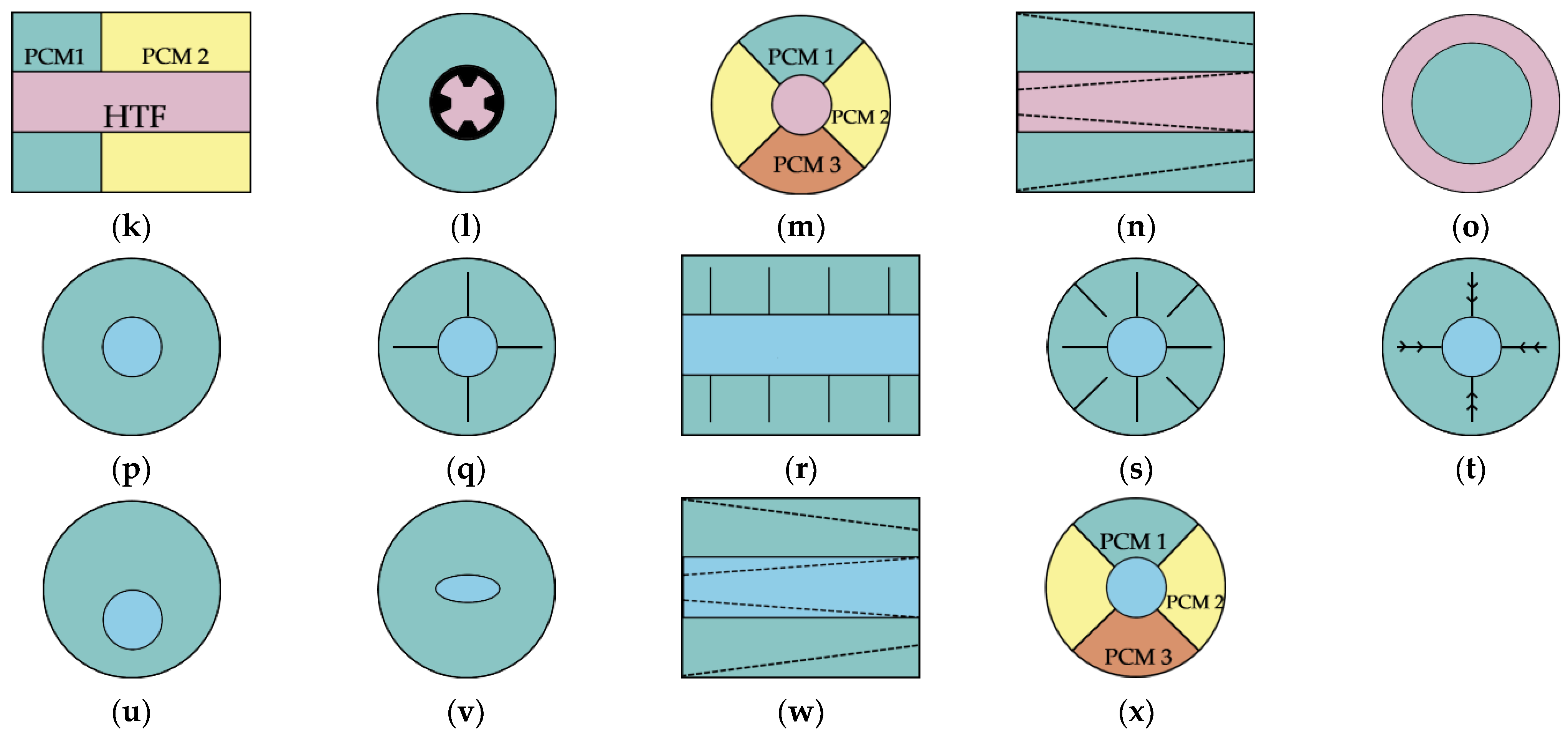
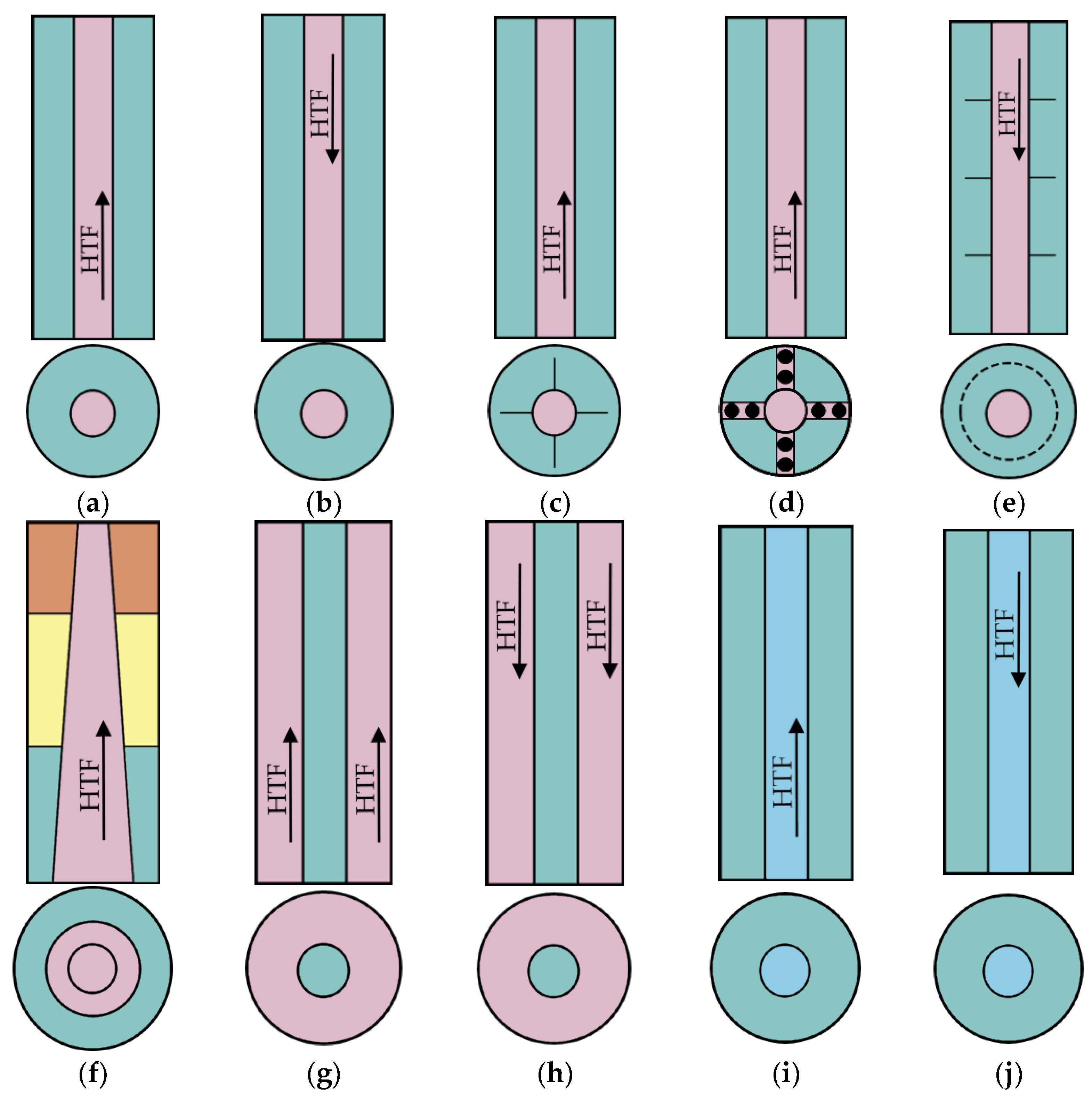
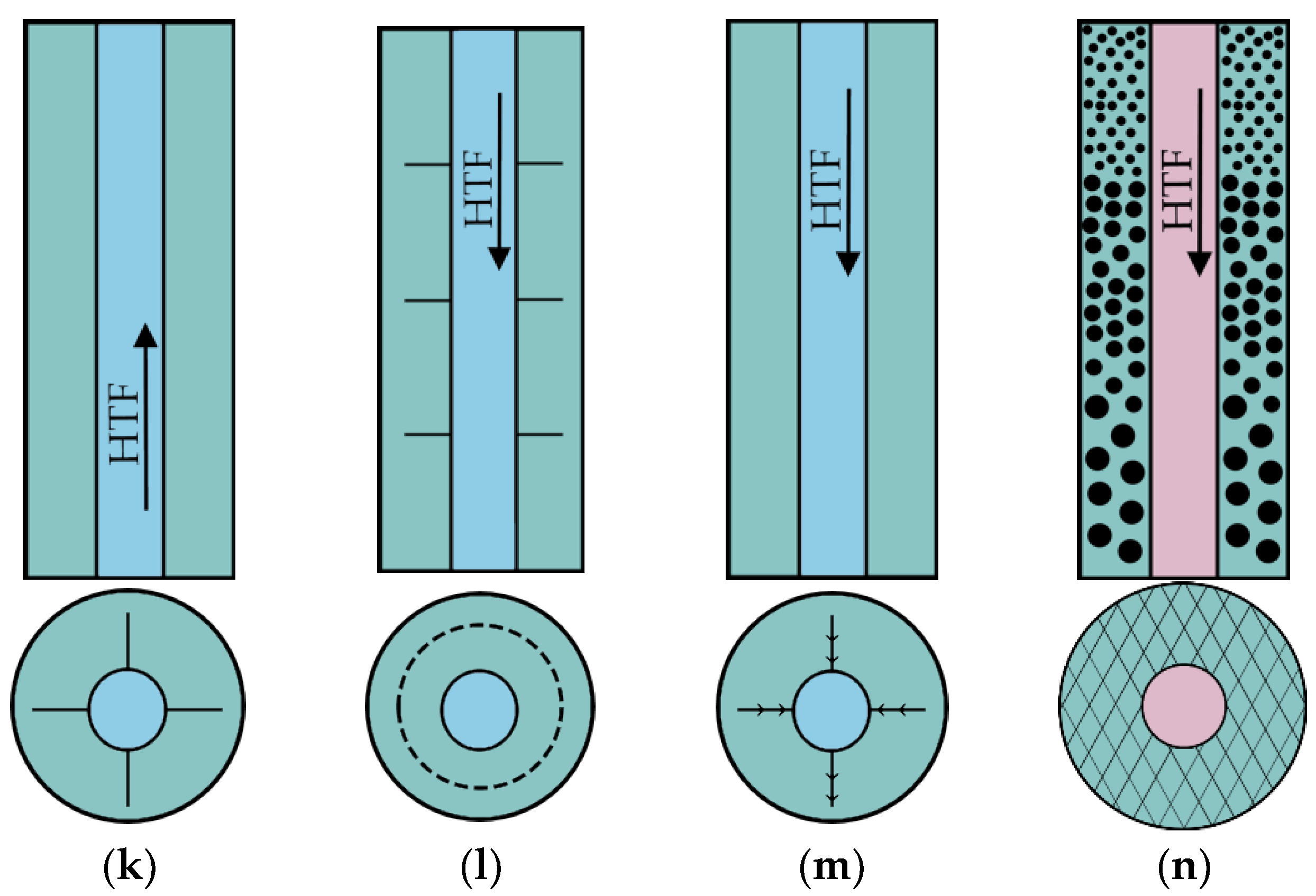
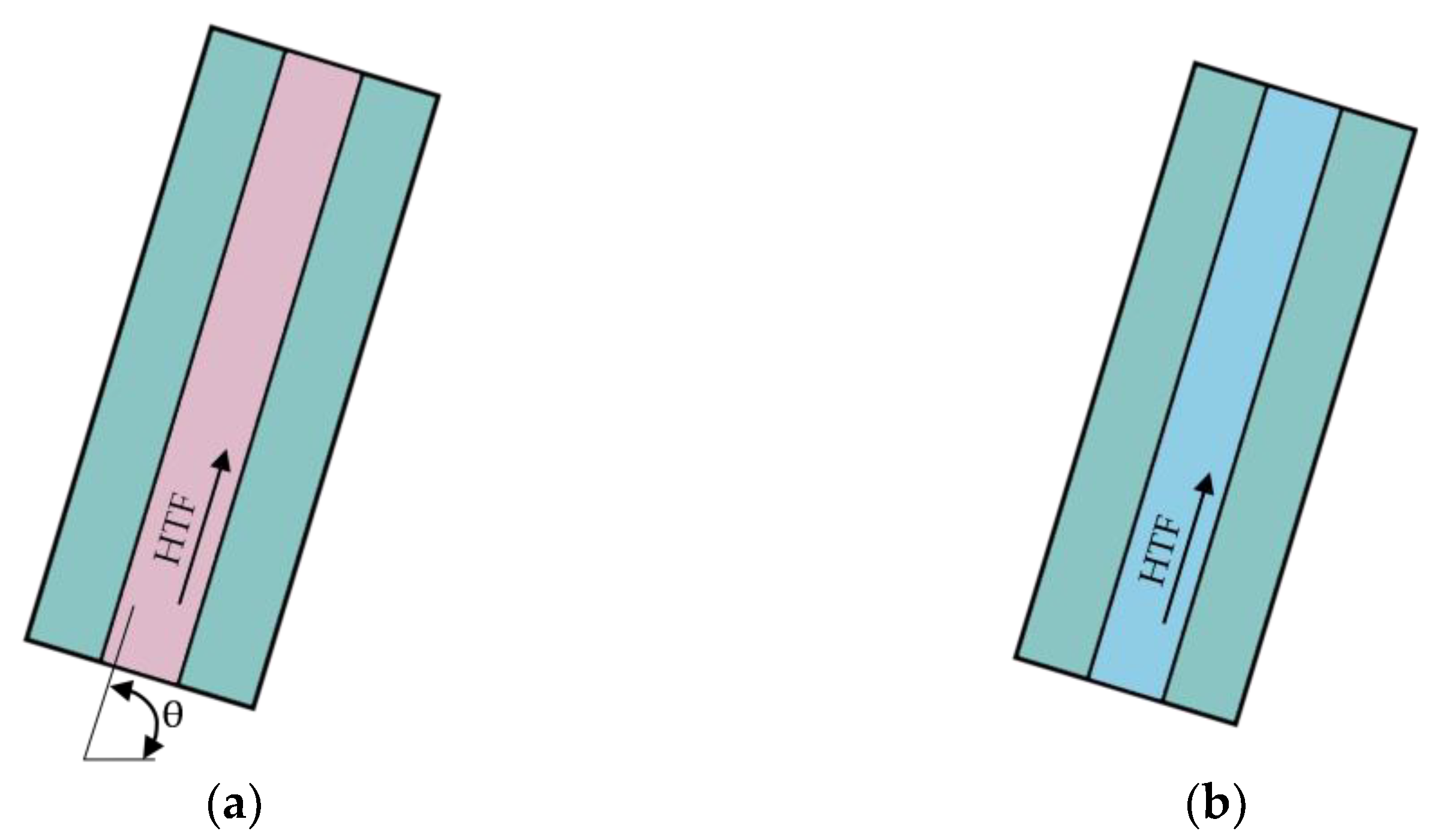
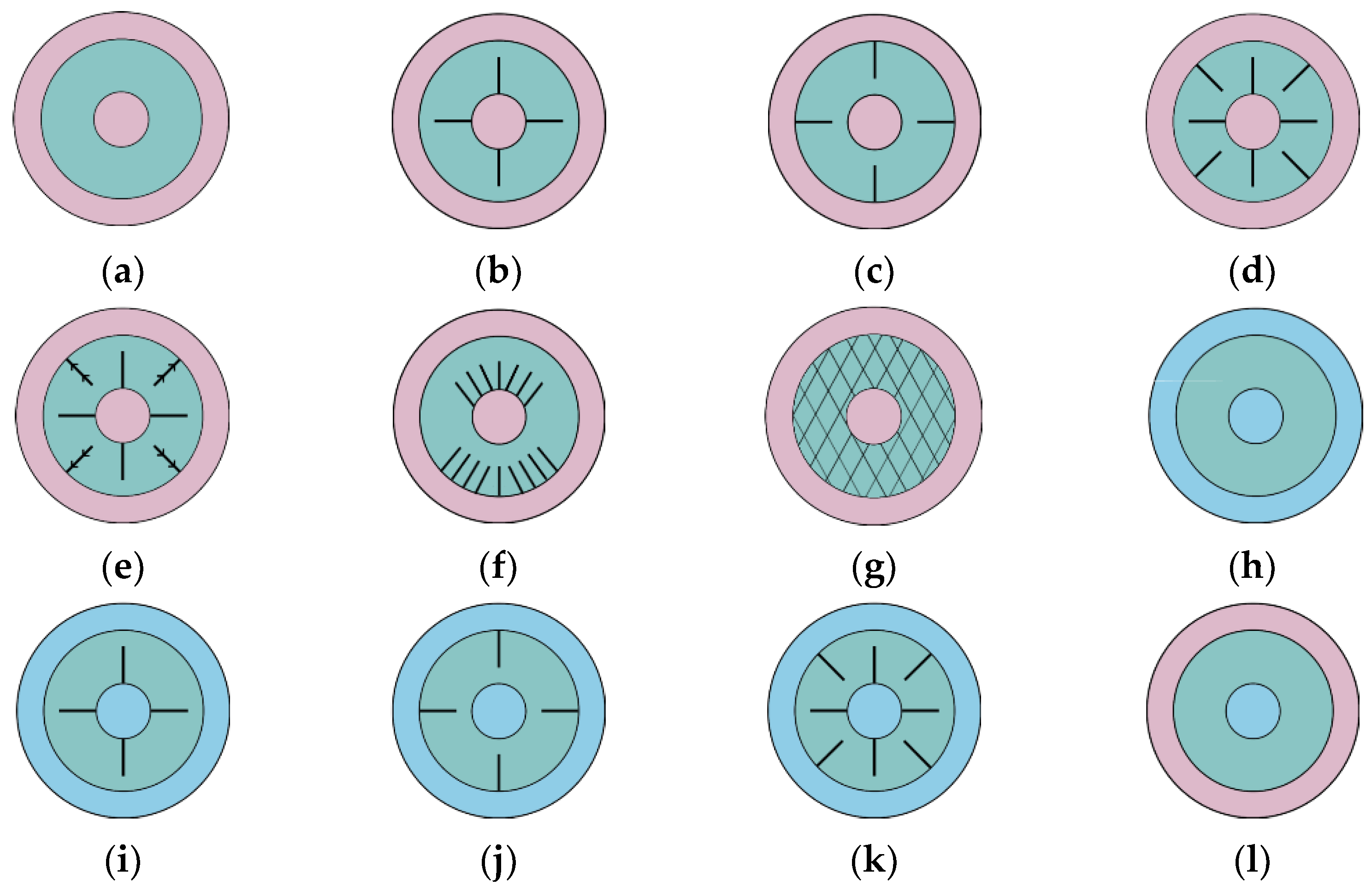

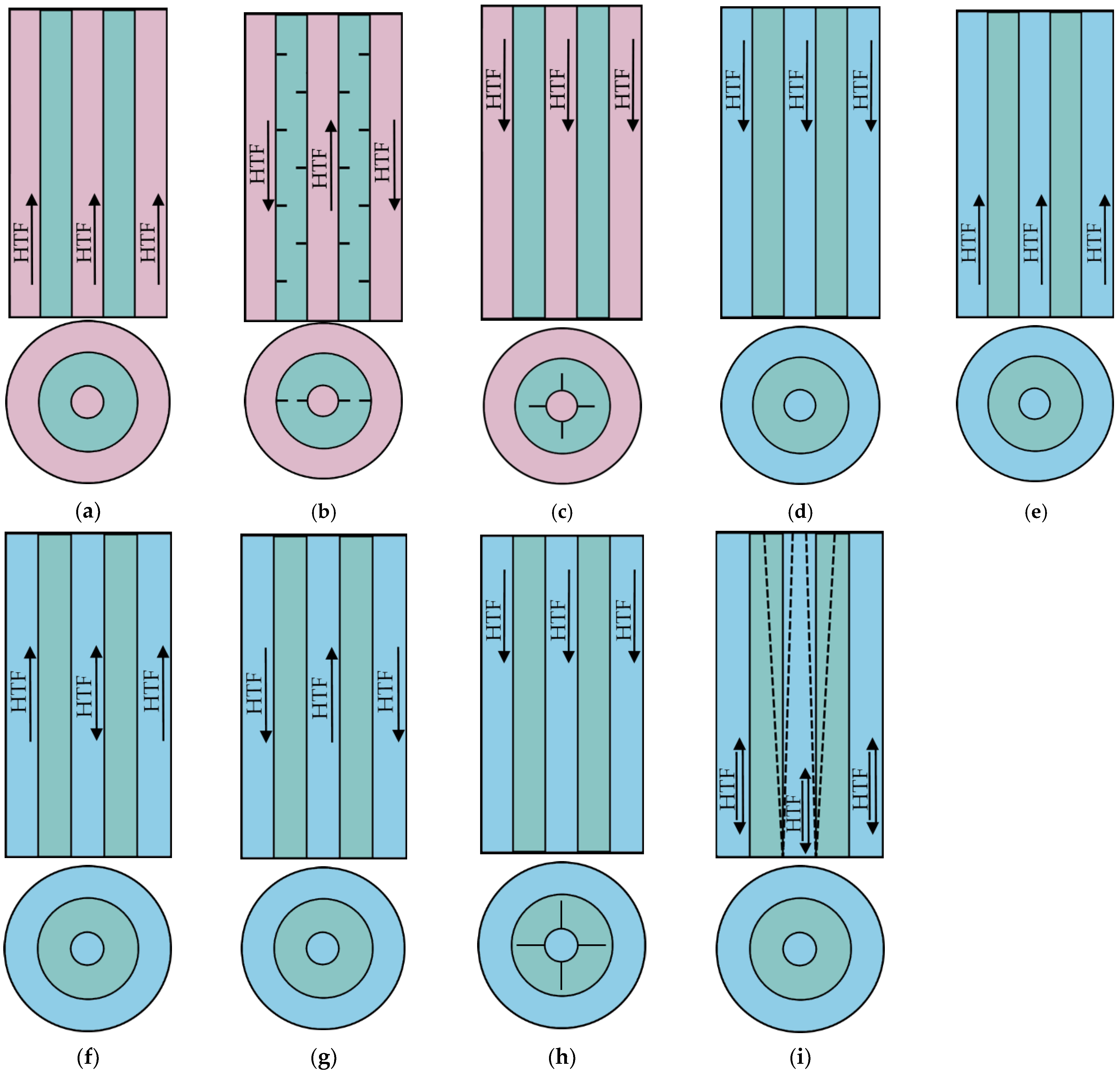
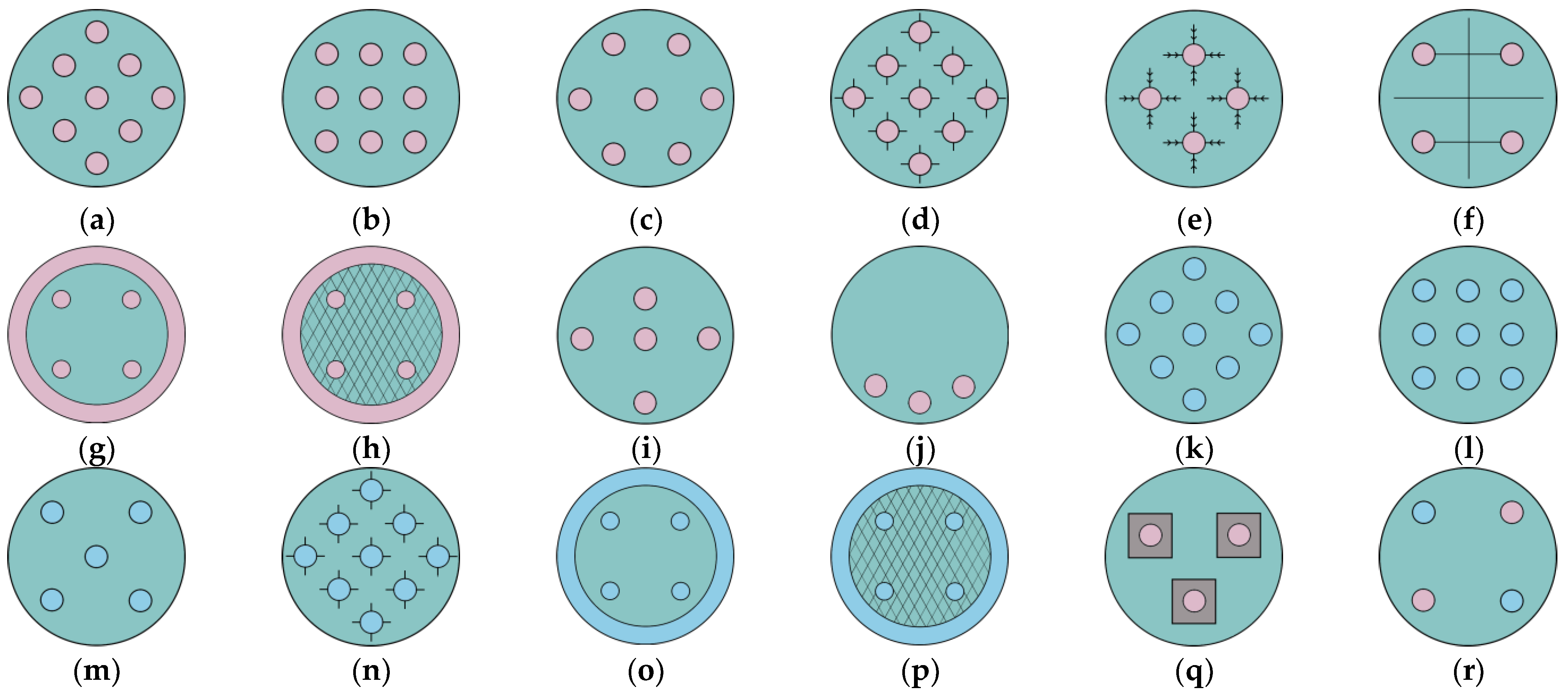

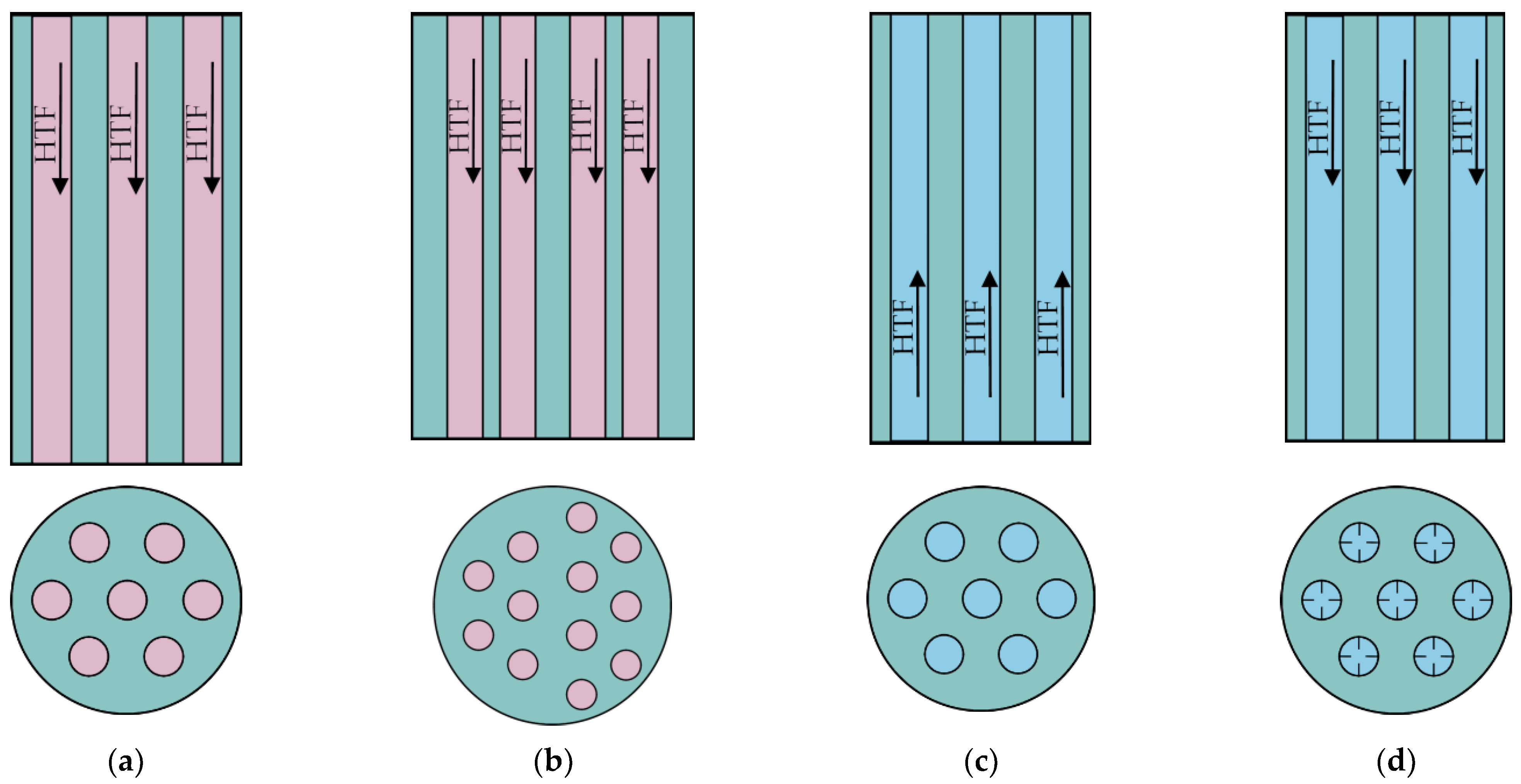

Disclaimer/Publisher’s Note: The statements, opinions and data contained in all publications are solely those of the individual author(s) and contributor(s) and not of MDPI and/or the editor(s). MDPI and/or the editor(s) disclaim responsibility for any injury to people or property resulting from any ideas, methods, instructions or products referred to in the content. |
© 2023 by the authors. Licensee MDPI, Basel, Switzerland. This article is an open access article distributed under the terms and conditions of the Creative Commons Attribution (CC BY) license (https://creativecommons.org/licenses/by/4.0/).
Share and Cite
Cieśliński, J.T.; Fabrykiewicz, M. Thermal Energy Storage with PCMs in Shell-and-Tube Units: A Review. Energies 2023, 16, 936. https://doi.org/10.3390/en16020936
Cieśliński JT, Fabrykiewicz M. Thermal Energy Storage with PCMs in Shell-and-Tube Units: A Review. Energies. 2023; 16(2):936. https://doi.org/10.3390/en16020936
Chicago/Turabian StyleCieśliński, Janusz T., and Maciej Fabrykiewicz. 2023. "Thermal Energy Storage with PCMs in Shell-and-Tube Units: A Review" Energies 16, no. 2: 936. https://doi.org/10.3390/en16020936
APA StyleCieśliński, J. T., & Fabrykiewicz, M. (2023). Thermal Energy Storage with PCMs in Shell-and-Tube Units: A Review. Energies, 16(2), 936. https://doi.org/10.3390/en16020936







